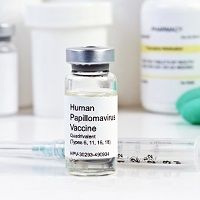Article
HPV Prevalence Decreases Suggesting Herd Immunity Benefits
Author(s):
From 2009–2014, vaccine-type HPV among unvaccinated 18–26 year olds decreased 50%.

The decline in prevalence of vaginal human papillomavirus (HPV) infections from 2009—2010 and 2013–2014 among both vaccinated and unvaccinated US women suggests the benefit from herd immunity in the introduction of the HPV vaccine, according to a study in Obstetrics and Gynecology.
Since the introduction of the quadrivalent HPV vaccine in the US in 2006, vaginal infections caused by vaccine-type strains have decreased.
Recent studies demonstrated the prevalence of HPV-6, -11, -16 and -18 decreased from 15.4% in 2009—2010 to 8.5% in 2011–2012 in women 18–26 years old, while a separate study observed declines in vaccine-type HPV among those 14–19 years old from 11.5% in the prevaccine years to 4.3% by 2012, and from 18.5% to 12.1% among women 20–24 years old.
A third study examined data through 2012, and reported a decline in quadrivalent vaccine-type HPV among vaccinated women 18—29 years old, but saw no decline among unvaccinated counterparts.
A more recent study conducted by University of Texas Medical Branch in Galveston, collected national data from 2013—2014 and examined whether future changes occurred in the US stratifying by age to more closely examine changes in prevalence with different levels of HPV vaccination, and by status to determine whether there was evidence of herd immunity at the national level.
The study evaluated HPV prevalence of vaccine-type HPV from 2009—2010 to 2013–2014 among women aged 18–59 years old, using cross-sectional survey data from 3 different cycles of the National Health and Nutrition Examination Survey. In addition to being interview and examined, participants were asked to self-collect a vaginal swab for HPV testing.
Researchers found a decrease in the prevalence of vaccine-type HPV, however, it was only significant in 18—26 years old, while the sample was stratified into 4 age groups 18–26, 27–34, 35–44, and 45–40. Because this age group was the only subgroup to demonstrate a significant change and it had the highest vaccination rate, HPV vaccination is likely the cause of decline.
Among vaccinated women 18—26 years old, prevalence remained low from 2009–2010 (3.9%) to 2013–2014 (2%), while unvaccinated women 18–26 years old demonstrated a significant decrease from 19.5% in 2009–2010 to 9.7% in 2013–2014.
There was no significant decline in vaccine-type HPV prevalence among vaccinated 18—26 year olds which is likely the result of low prevalence in 2009–2010 and 2013–2014. The prevalence however, did not significantly change among unvaccinated women 26 years or older.
No change was observed in the prevalence of gonorrhea or chlamydia, herpes simplex virus type 2, or high-risk unvaccinated-type HPV.
Findings indicate that vaccine-type HPV prevalence is continuing to fall in the US. The decline in infections in unvaccinated 18—26 year olds provides early evidence that women in the US are beginning to benefit from herd immunity resulting from the introduction of the vaccine. If strengthened, the herd effect could offer protection to individuals unable to be vaccinated, helping to further reduce HPV-associated cancers.
The study, “Change in Human Papillomavirus Prevalence Among U.S. Women Aged 18—59 Years, 2009–2014” can be found in Obstetrics and Gynecology.





